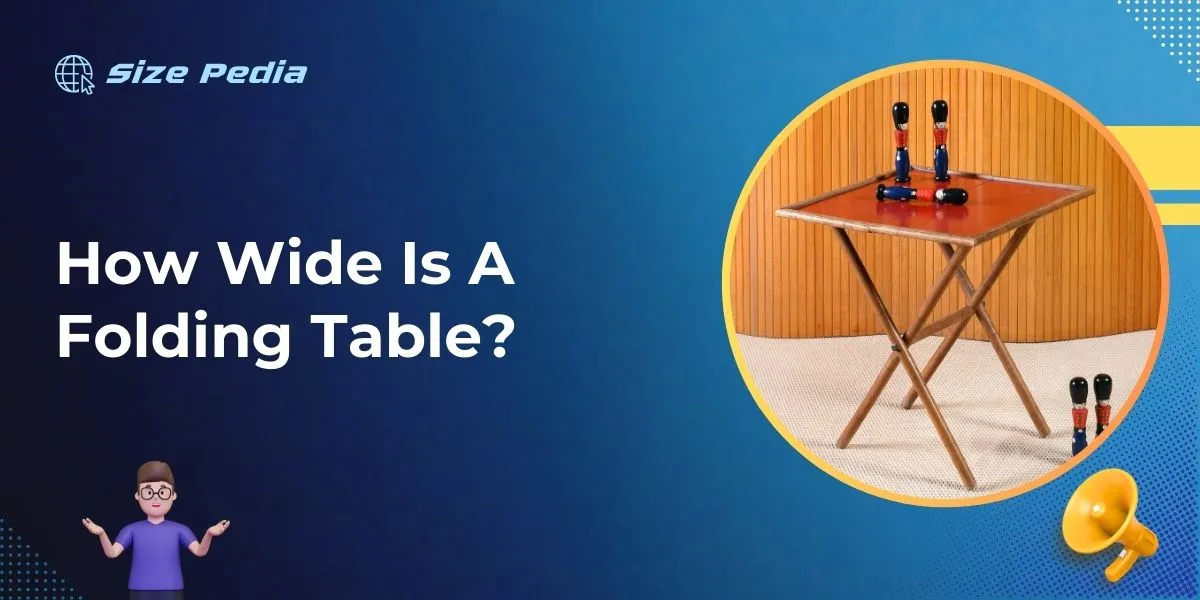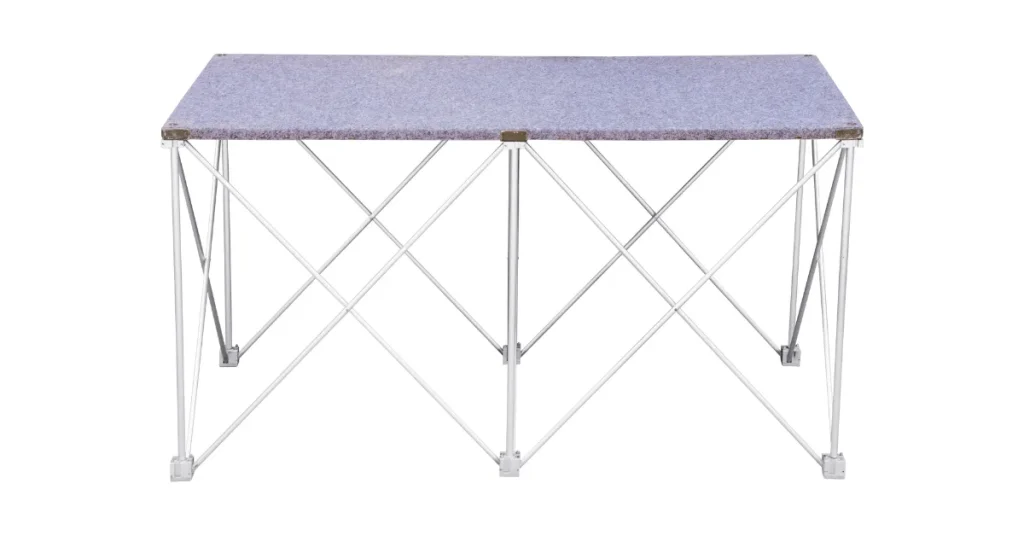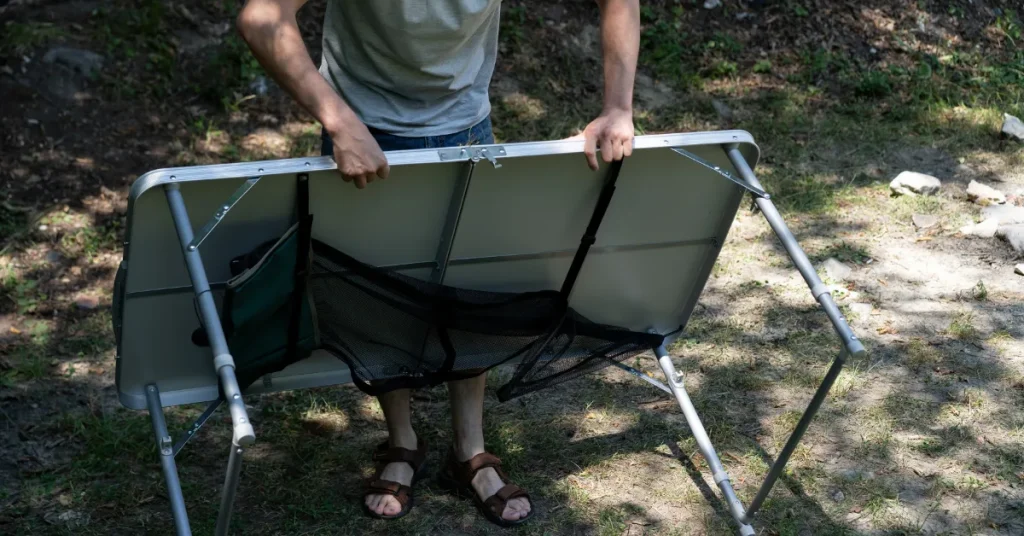A folding table typically ranges from 18 to 30 inches in width. Common widths are 24, 28, and 30 inches to match various needs.
Folding tables are versatile pieces of furniture designed for both indoor and outdoor use. They provide convenient, portable surfaces for events, gatherings, or personal use.
Their widths vary to suit different spaces, from narrow corridors to spacious dining halls, ensuring they can be easily integrated into an array of settings.
The size and design of a folding table play a crucial role in event planning, space management, and ergonomic comfort. Their collapsible nature makes them ideal for storage and transportation, offering a practical solution for those with limited space.
Ideal for homes, offices, and banquet venues, folding tables are a staple for adding temporary workspace wherever it’s needed.

Standard Dimensions Of Folding Tables
Folding tables are incredibly versatile and convenient for a multitude of settings, from picnics to conference rooms.
Standard dimensions vary, but most are designed to be compact and easy to store. Understanding common sizes helps in selecting the right table for any event or space.
Popular Shapes And Their Sizes
Different events call for different table shapes. Here’s a quick guide:
- Rectangular: Often 6 to 8 feet in length
- Square: Typically 34 inches on each side
- Round: Common diameters are 48, 60, and 72 inches
For easy reference, here’s a table of popular sizes:
| Shape | Common Sizes (Width x Length/ Diameter) |
| Rectangular | 30″ x 72″, 30″ x 96″ |
| Square | 34″ x 34″ |
| Round | 48″, 60″, 72″ diameters |
Height Variations Explained
The height of folding tables can affect comfort and function.
- Standard height: Typically, 29 inches
- Counter height: Usually around 36 inches
- Bar height: Often near 42 inches
Children’s folding tables are lower, generally about 22 to 26 inches high.
Adjustable height tables cover various needs, ranging from 22 to 32 inches.
Factors That Impact Folding Table Width
An important aspect to consider before buying a folding table is its width. The width of a folding table influences its functionality and storage. Several factors determine the optimal width for your needs.
Material And Design Considerations
The materials and design of a folding table are key in determining its width. Heavier materials like wood may require a wider base for stability. Conversely, lightweight materials like aluminum allow for slimmer designs without sacrificing strength.
- Wood: Often wider for balance.
- Plastic: Can be narrow with reinforced designs.
- Metal: Allows for varying widths based on design.
Construction techniques also play a role, with certain joinery or folding mechanisms adding to the overall width.
Intended Use And Capacity
The intended use of a folding table greatly impacts its width. A table for dining will differ in width from one designed for conference attendees.
Consider the following for use and capacity:
| Dining | Typically wider to accommodate place settings and centerpieces. |
| Conferences | May be narrower to fit more seats in a row. |
| Displays | Narrower tables often suffice to present materials. |
Think about the number of people using the table. More users usually require a wider table.
Choosing The Right Size For Your Space

Folding tables are versatile for varied activities, from crafting to banquets. The success of your event hinges on selecting the right table size. It ensures comfort while optimizing your space. Let’s explore how to choose the perfect folding table dimensions.
Measuring Your Area
Before buying a folding table, measure your space. Start with the length and width of the area where the table will go. Use a tape measure and note down the measurements. Consider doorways, staircases, and elevators. These details dictate table size and ease of transport.
- Length of the area
- Width of the area
- Clearance for doors and passages
Record dimensions on paper or a digital device. These numbers guide you to a suitable table size. Here’s a simple method to measure:
- Extend the tape measure from one end of the space to the other.
- Record the longest side as the length.
- Mark the shorter side as the width.
- Check for any obstructions that might hinder setup or usage.
Considering Movement And Flow
Space around the table is crucial. Guests need room to move comfortably. Remember the purpose of your folding table.
A dining event requires more space than a conference. Aim for at least 30 inches of clearance from the table edge to the nearest obstruction. This allows for chair access and free movement.
| Event Type | Clearance Needed |
| Dining | 30-36 inches |
| Conference | 24-30 inches |
| Displays or Fairs | 18-24 inches |
This simple table reference serves as your guide. Keep in mind that extra room enhances guest experience. Few activities are more frustrating than squeezing through tight spaces. Particularly when carrying plates or materials.
Choosing the right table width and length ensures a comfortable, functional space. A precise fit makes all the difference.
Take your time, measure carefully, and consider movement needs. This results in a well-planned setting that maximizes the utility and comfort of your folding table.
Customization And Adjustable Options
Customization and Adjustable Options are a game-changer for those seeking versatility in folding tables.
With a wide range of sizes, modern folding tables cater to different space requirements and functionalities, making them ideal for events, family gatherings or home use.
Extendable designs and modular systems take adaptability to the next level, ensuring that users can tailor their folding tables to any occasion.
Extendable Designs
Extendable designs bring flexibility and convenience to the forefront. A standard folding table’s width can transform with the addition of extendable sections. These allow for extra guests or display items without sacrificing portability.
Structured to be strong and easy to use, extendable folding tables become wider with a simple pull or slide action.
- Easy to operate: Users can extend the table in seconds.
- Space-saving: When not needed, retract to the original size.
- Versatile: Ideal for indoor or outdoor use.
Modular Table Systems
Modular table systems embody innovation. Multiple table units can be connected to form a variety of configurations. Fully customize the width, creating a personalized surface area that serves diverse needs.
These systems provide robust solutions for events requiring vast, cohesive table settings or smaller, separate areas.
| Feature | Benefit |
| Interlocking Units | Secure and stable extended surfaces |
| Adjustable Width | Custom fit for any occasion |
| Easy Storage | Compact design saves space |
Both extendable designs and modular table systems offer the perfect blend of practicality and innovation. These tables adapt to fit your space and needs, providing a reliable, adjustable solution for any event.
Caring For Your Folding Table

Your folding table offers convenient versatility whether it’s for a family gathering, a craft corner, or an outdoor picnic. Proper care ensures it remains a reliable surface for years to come. Below are essential tips for maintaining the beauty and functionality of your folding table.
Maintenance Tips
Keeping your folding table clean and functional requires regular upkeep. Follow these steps to maintain your table:
- Wipe down surfaces after use with a damp cloth.
- Avoid harsh chemicals that could damage the finish.
- Check and tighten loose bolts periodically.
- Use a silicone spray to lubricate the hinges, ensuring smooth folding.
Storage Solutions
Correct storage of your folding table prolongs its lifespan. Consider these storage tips:
- Clean your table thoroughly before storing.
- Store in a dry, indoor area to prevent rust and wood warping.
- Keep away from extreme temperatures which can cause expansion and contraction.
- Use table covers or storage bags to protect against dust and scratches.
By following these maintenance and storage solutions, your folding table will remain sturdy, clean, and ready for your next event.
FAQs About How Wide Is A Folding Table
What Are The Dimensions Of A 6 Foot Folding Table?
A standard 6-foot folding table typically measures about 72 inches in length, 30 inches in width, and 29 inches in height.
How Wide Should A Folding Table Be?
The width of a folding table typically ranges from 18 to 30 inches, depending on its intended use and design.
How Wide Is A 4ft Folding Table?
A 4ft folding table typically measures about 48 inches in width. This convenient size accommodates various activities and fits easily into different spaces.
How Wide Is A 5 Foot Table?
A 5-foot table typically measures 60 inches wide, translating to its 5-foot designation. Its width accommodates various activities and seating arrangements.
Conclusion
Selecting the perfect folding table size starts with understanding your space and needs. Common widths range from 18 inches to 30 inches, catering to various events and functions.
Remember, the ideal width enhances comfort and convenience, helping you host with ease.
Choose wisely for a seamless fit every time.
Resources:
1. https://www.in.gov/idoc/indianacorrectionalindustries/files/FoldingTables-11.21-.pdf
